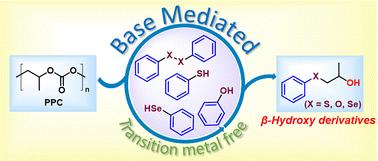可持续碱介导的聚碳酸丙烯化学升级回收制β-羟基硫化物和氧化物
IF 9.2
1区 化学
Q1 CHEMISTRY, MULTIDISCIPLINARY
引用次数: 0
摘要
我们提出了一种碳酸铯介导的方法,通过选择性热解聚将聚碳酸丙烯(PPC)废物升级为β-羟基硫化物、硒化物和苯氧化物。该工艺可耐受多种亲核试剂,包括来自多层塑料的亲核试剂。机理研究支持芳基硫酸铯驱动的亲核降解。β-羟基产物易于功能化,碱是可回收的,为PPC增值提供了可持续的途径。本文章由计算机程序翻译,如有差异,请以英文原文为准。

Sustainable base-mediated chemical upcycling of poly (propylene carbonate) to β-hydroxy sulfides and oxides
We present a cesium carbonate–mediated method to upcycle poly(propylene carbonate) (PPC) waste into β-hydroxy sulfides, selenides, and phenoxides via selective thermal depolymerization. The process tolerates diverse nucleophiles, including those from multilayer plastics. Mechanistic studies support a cesium aryl thiolate–driven nucleophilic degradation. The β-hydroxy products are easily functionalized, and the base is recyclable, offering a sustainable route for PPC valorization.
求助全文
通过发布文献求助,成功后即可免费获取论文全文。
去求助
来源期刊

Green Chemistry
化学-化学综合
CiteScore
16.10
自引率
7.10%
发文量
677
审稿时长
1.4 months
期刊介绍:
Green Chemistry is a journal that provides a unique forum for the publication of innovative research on the development of alternative green and sustainable technologies. The scope of Green Chemistry is based on the definition proposed by Anastas and Warner (Green Chemistry: Theory and Practice, P T Anastas and J C Warner, Oxford University Press, Oxford, 1998), which defines green chemistry as the utilisation of a set of principles that reduces or eliminates the use or generation of hazardous substances in the design, manufacture and application of chemical products. Green Chemistry aims to reduce the environmental impact of the chemical enterprise by developing a technology base that is inherently non-toxic to living things and the environment. The journal welcomes submissions on all aspects of research relating to this endeavor and publishes original and significant cutting-edge research that is likely to be of wide general appeal. For a work to be published, it must present a significant advance in green chemistry, including a comparison with existing methods and a demonstration of advantages over those methods.
 求助内容:
求助内容: 应助结果提醒方式:
应助结果提醒方式:


